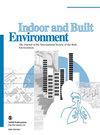空调用自然对流辐射蒸发器的热舒适性评估
IF 2.9
3区 工程技术
Q2 CONSTRUCTION & BUILDING TECHNOLOGY
引用次数: 0
摘要
辐射系统因其节能潜力和良好的集成性而备受关注。不同形式的冷表面对人体热舒适度的影响是其应用的重点。我们开发了一种用于热泵的新型自然对流辐射蒸发器,并研究了其对热舒适度的影响。建立了带有蒸发器的室内数值模型,并与实验结果进行了验证。在气候室中进行了热舒适性实验,研究了不对称和不均匀冷辐射对热舒适性的影响。由于 PMV 在不均匀辐射情况下的局限性,在实验结果的基础上,提出了修正预测平均值(RPMV)来评估不对称和不均匀辐射环境下的热舒适性。基于 RPMV,对蒸发器的表面积和温度对热舒适度的影响进行了数值分析。结果表明,室内空气温度和相对湿度、RPMV 随蒸发板温度的增加而增加,但随蒸发板面积的增加而减少。在室内空气温度为 28°C、相对湿度为 50%(比传统空调系统高 2°C)的条件下,获得了最理想的室内热舒适环境。本文章由计算机程序翻译,如有差异,请以英文原文为准。
Thermal comfort evaluation of natural convective-radiant evaporator for air conditioning
The radiant systems come to the fore due to energy saving potential and good integration. The effect of different forms of cold surfaces on human thermal comfort is focused on its application. A novel natural convection-radiant evaporator for heat pumps was developed and its influence on thermal comfort was investigated. A numerical model of the chamber with the evaporator was established and verified with experimental results. Thermal comfort experiments were conducted in a climate chamber and the influence of its asymmetric and uneven cold radiation on the thermal comfort was investigated. Due to the limitation of PMV in uneven radiation situations, the revised predicted mean vote (RPMV) was proposed to assess the thermal comfort in asymmetric and uneven radiation environments based on experimental results. Based on RPMV, the influence of the surface area and temperature of the evaporator on thermal comfort was numerically analyzed. The results indicate that indoor air temperature and relative humidity, RPMV increase with the increase of plate temperature, but decrease with an increase in plate area. The most favourable indoor thermal comfort environment was obtained at an indoor air temperature of 28°C and relative humidity of 50%, which is 2°C higher than traditional air conditioning system.
求助全文
通过发布文献求助,成功后即可免费获取论文全文。
去求助
来源期刊

Indoor and Built Environment
环境科学-工程:环境
CiteScore
6.40
自引率
25.00%
发文量
130
审稿时长
2.6 months
期刊介绍:
Indoor and Built Environment publishes reports on any topic pertaining to the quality of the indoor and built environment, and how these might effect the health, performance, efficiency and comfort of persons living or working there. Topics range from urban infrastructure, design of buildings, and materials used to laboratory studies including building airflow simulations and health effects. This journal is a member of the Committee on Publication Ethics (COPE).
 求助内容:
求助内容: 应助结果提醒方式:
应助结果提醒方式:


